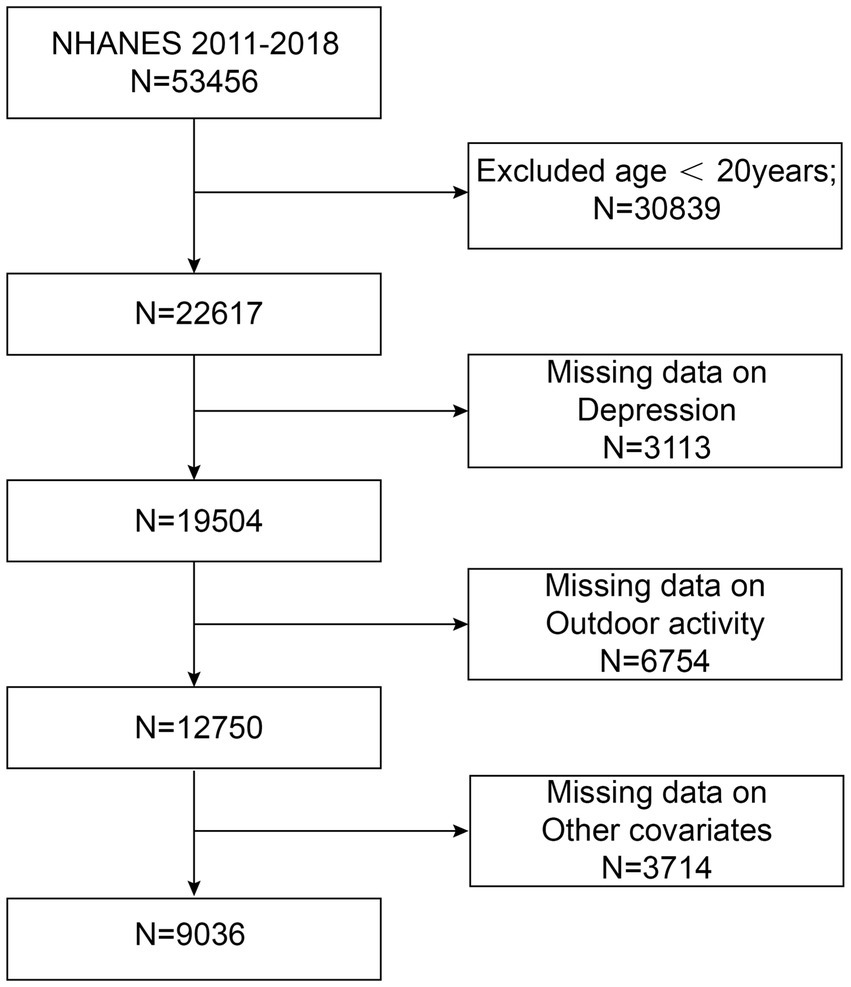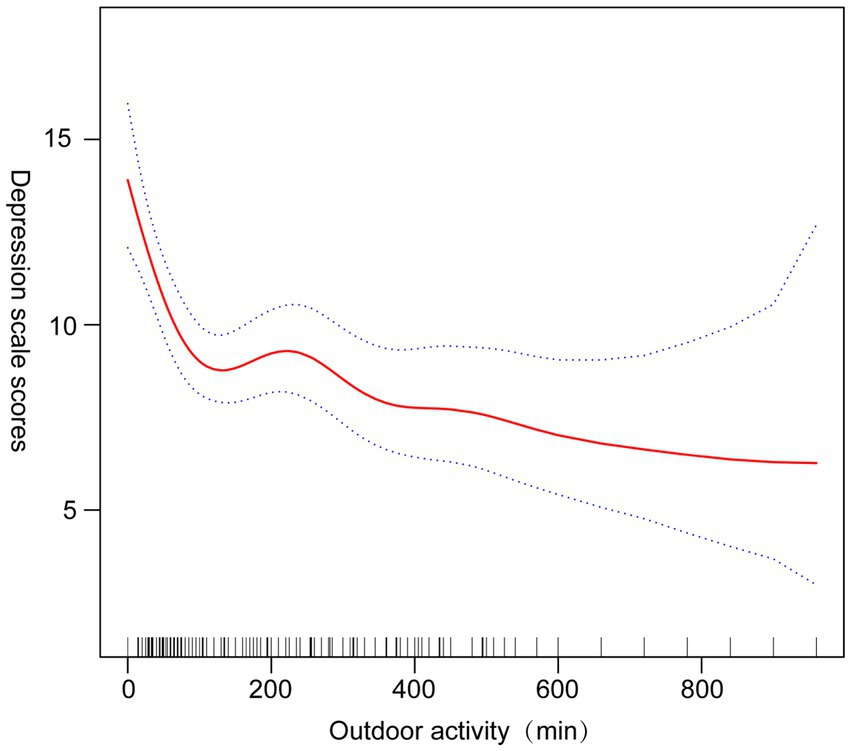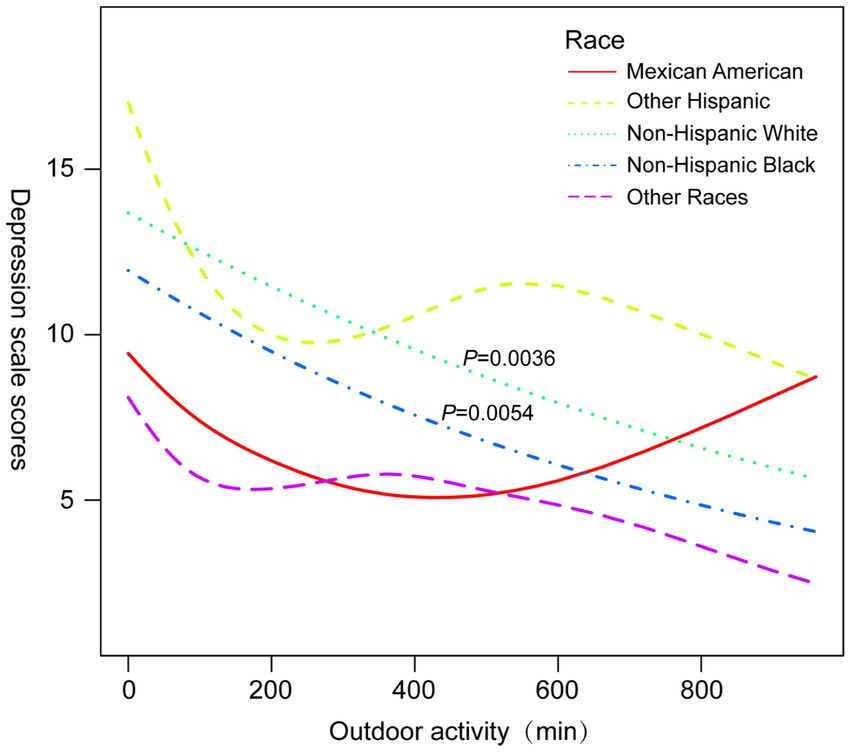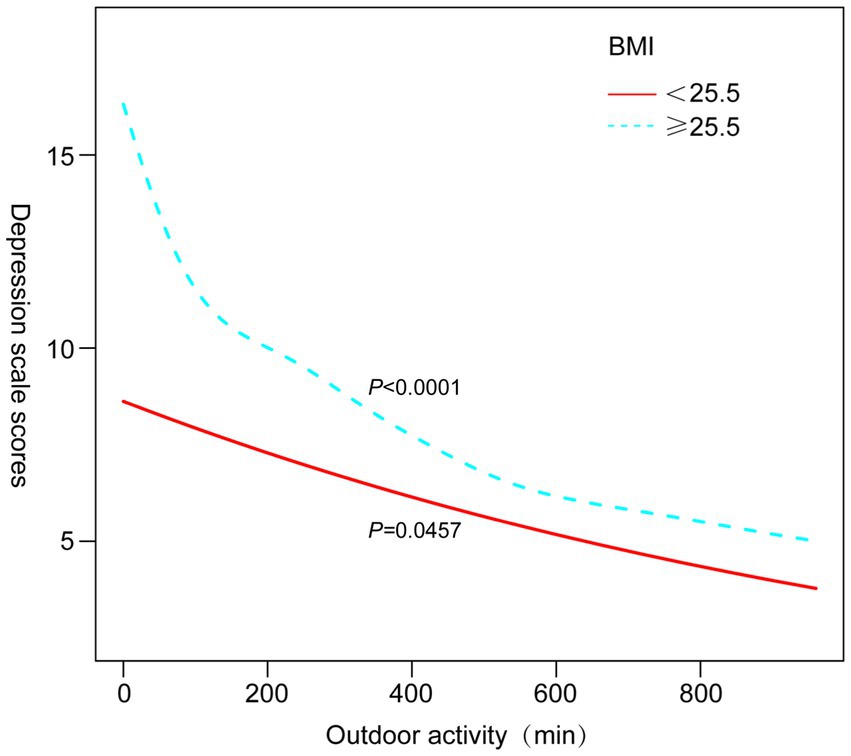- 1Comprehensive Pediatrics, Kunming Children's Hospital, Kunming, China
- 2Department of Anesthesiology, Kunming Children's Hospital, Kunming, China
Background: Depression is a significant global public health issue, affecting millions worldwide. Outdoor activities have shown potential mental health benefits, but the specific mechanisms and influencing factors remain unclear.
Objectives: This study aimed to investigate the association between time spent outdoors and depression risk among U.S. adults, with a focus on variations across age and ethnic groups.
Methods: Using data from the NHANES 2011–2018 survey, we analyzed 9,036 adults aged 20 years and older. Participants self-reported their outdoor activity time and depressive symptoms. Statistical analysis, accounting for various demographic and lifestyle factors, was employed to assess the relationship between outdoor activity and depression risk.
Results: Spending more time outdoors was associated with a 51% lower risk of depression (odds ratio: 0.51, 95% CI: 0.40–0.64). Subgroup analysis revealed that this association was particularly pronounced among adults aged 40 and older, as well as non-Hispanic whites and non-Hispanic blacks.
Conclusion: Encouraging outdoor activities may represent an effective public health strategy to reduce depression risk, particularly among middle-aged and older adults and specific ethnic populations. Public health policies should prioritize initiatives that encourage outdoor engagement, and future research is needed to explore the underlying mechanisms and population-specific responses to outdoor activity.
Introduction
Depression is a leading cause of disability worldwide, affecting an estimated 300 million individuals and contributing significantly to global disease burden and economic challenges (Frühauf et al., 2016). In the United States alone, depression impacts nearly 8.4% of adults annually, highlighting the critical need for effective prevention and treatment strategies (Owens and Bunce, 2022).
Among various interventions, outdoor activities have gained attention due to their potential to promote mental health through unique physiological and psychological mechanisms. These include enhancing physical activity, increasing vitamin D synthesis, improving sleep quality, and reducing stress (Hahn et al., 2011). Unlike pharmacological or purely psychological approaches, outdoor activities offer a holistic and accessible option for many populations, making them particularly worthy of focused research.
Previous studies have provided valuable insights into the benefits of outdoor activities. For instance, Frühauf et al. (2016) demonstrated that outdoor exercise significantly improved mood and psychological well-being, outperforming indoor exercise in boosting vitality and positivity (Buckley et al., 2018). Owens and Bunce (2022) further proposed that natural environments enhance mental health by reducing stress, decreasing rumination, and fostering positive thought patterns (Hahn et al., 2011). However, not all studies have reached consistent conclusions, with some failing to identify significant associations (Frühauf et al., 2016). These discrepancies underscore the influence of cultural, environmental, and socioeconomic factors on the effectiveness of outdoor activities (Wicks et al., 2022). Additionally, individual differences such as age and ethnicity may shape responses to outdoor activities. Despite these variations, limited research has systematically explored how these demographic factors impact the relationship between outdoor activity and depression. Addressing this gap is crucial to developing targeted, equitable public health interventions (Zhang, 2017).
This study aims to evaluate the relationship between time spent outdoors and depression among U.S. adults using NHANES 2011–2018 data. By focusing on differences across age and ethnic groups, this research seeks to provide robust evidence for integrating outdoor activities into public health strategies and tailoring interventions to meet the needs of diverse populations (Wheeler et al., 2020).
Methods
Study population and data sources
This cross-sectional study utilized data from the National Health and Nutrition Examination Survey (NHANES), a program conducted by the Centers for Disease Control and Prevention (CDC). NHANES uses a stratified, multistage probability sampling design to collect data representative of the civilian noninstitutionalized U.S. population. Oversampling of certain subgroups, such as older adults and minority populations, ensures robust analysis across demographic categories. Detailed sampling methods are available on the NHANES website.1
We analyzed data from NHANES 2011–2018, which included a total of 53,456 participants. After limiting the dataset to individuals aged ≥20 years, we excluded participants with missing depression scores (N = 3,113), outdoor activity data (N = 6,754), and other covariates (N = 3,714), resulting in a final analytical sample of 9,036 participants. The participant selection process is outlined in Figure 1.
Variables in research
Outdoor activity
Outdoor activity time was measured using the Physical Activity Questionnaire, derived from the Global Physical Activity Questionnaire (GPAQ). Participants reported durations of various outdoor activities, such as walking, jogging, gardening, and other leisure-time exercises. Data were collected using the Computer-Assisted Personal Interviewing (CAPI) system, with implausible responses (e.g., >24 h/day) excluded during data processing to ensure validity.
Depression
Depressive symptoms were assessed using the Patient Health Questionnaire (PHQ-9), a validated tool consisting of nine questions on symptom frequency over the past 2 weeks. Responses ranged from 0 (“not at all”) to 3 (“nearly every day”), with total scores (0–27) indicating severity. Interviews were conducted privately using CAPI in English or Spanish to reduce recall and reporting bias.
Covariates
Categorical variables: Gender, race/ethnicity (Mexican American, other Hispanic, non-Hispanic black, non-Hispanic white, or other), education level, marital status, high blood pressure status, diabetes status, smoking status (≥100 lifetime cigarettes or not), and daily alcohol consumption. Continuous variables: Body mass index (BMI, kg/m2) and daily sedentary time (minutes). Measurement protocols for all variables are publicly available on the NHANES website.
Statistical Models
Analysis approach
All statistical analyses were performed using R (version 3.4.3) and EmpowerStats software (version 4.1). Continuous variables were expressed as mean ± standard deviation (SD), and categorical variables as percentages. Baseline comparisons were conducted using linear regression models for continuous variables and chi-square tests for categorical variables. To investigate the association between outdoor activity time and depression risk, we developed three models with incremental adjustments to address potential confounding: Model 1 (Unadjusted): This model explored the crude relationship between outdoor activity and depression without adjusting for any confounders. Rationale: Establishes the baseline association and highlights the raw effect size. Model 2 (Partially Adjusted): Adjusted for age, gender, and race/ethnicity. Rationale: These primary demographic factors are strongly associated with both outdoor activity participation and mental health outcomes (U.S. Department of Health and Human Services, 2018). Adjusting for them helps isolate the association between outdoor activity and depression. Model 3 (Fully adjusted): included additional adjustments for education level, marital status, hypertension, diabetes, smoking status, alcohol consumption, BMI, and daily sedentary time. Rationale: these variables represent key health and lifestyle factors that may influence depression risk or participation in outdoor activities. For example, sedentary behavior is inversely associated with outdoor activity and is an independent predictor of depression (Pearce et al., 2022; Ströhle, 2009). Adjusting for these factors allows for a more comprehensive evaluation of the independent relationship between outdoor activity and depression.
Subgroup analyses
Subgroup analyses were conducted by gender, age, race/ethnicity, education level, and BMI. BMI was included as a stratification variable due to its dual association with physical activity and mental health, reflecting potential interactions between physical and psychological factors (Firth et al., 2020).
Ethics and data collection
The NHANES protocol was approved by the NCHS Ethics Review Board. Written informed consent was obtained from participants or their legal guardians. To minimize recall bias, data collection utilized validated tools (e.g., PHQ-9, GPAQ) and private, standardized interviews conducted via CAPI, ensuring consistent and accurate responses.
Results
Baseline characteristics
The baseline characteristics of 9,036 participants are summarized in Table 1. Participants with depression scores ≥10 were more likely to have sedentary time ≥ 480 min per week, outdoor activity <60 min per week, and higher BMI (31.48 ± 8.89 vs. 29.18 ± 7.29, p < 0.0001). This group also included a greater proportion of females (64.9%), individuals aged ≥40 years (56.0%), and those with lower educational attainment (25.69% with high school or below).
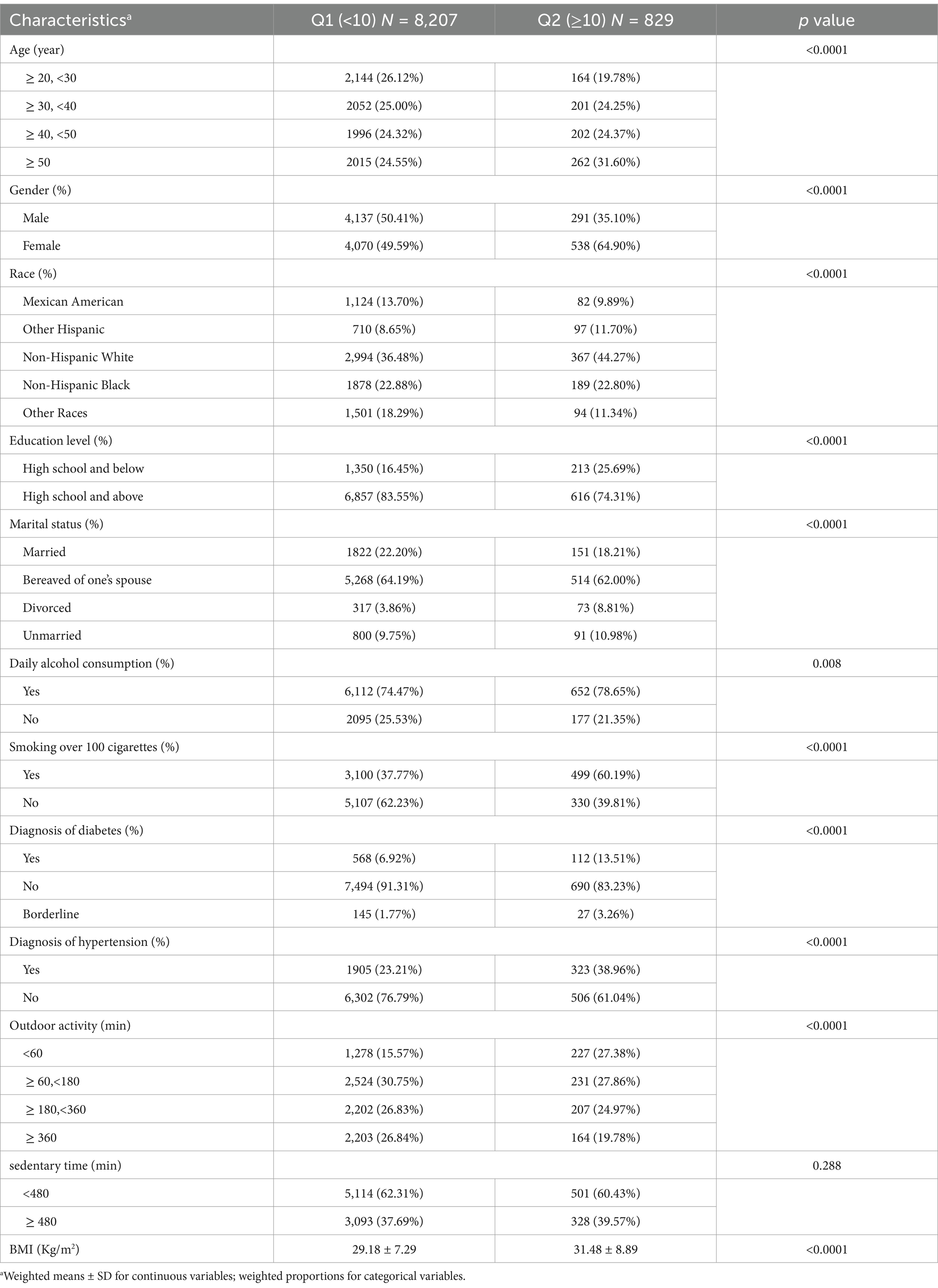
Table 1. Baseline characteristics of the study population stratified according to depression scores.
Association between outdoor activity and depression
Table 2 presents the relationship between time spent outdoors and depression risk. In the fully adjusted model, participants in the highest quartile of outdoor activity (≥360 min/week) had a 49% lower risk of depression compared to those in the lowest quartile (<60 min/week) (OR = 0.51, 95% CI 0.40–0.64, p < 0.0001). A smoothed curve fit (Figure 2) demonstrated a nonlinear negative association between outdoor activity and depression, with diminishing benefits at higher activity levels.
Subgroup analyses
Subgroup analyses (Table 3) revealed that the protective association between outdoor activity and depression was particularly significant among participants aged ≥40 years (OR = 0.67, 95% CI 0.54–0.83, p = 0.0003), non-Hispanic whites (OR = 0.42, 95% CI 0.34–0.52, p < 0.0001), and those with BMI ≥25.5 kg/m2 (OR = 0.60, 95% CI 0.49–0.74, p < 0.0001). Figures 3–6 illustrate these subgroup trends with annotations highlighting significant differences and key findings. Increasing outdoor activity time, especially for middle-aged and older adults, non-Hispanic whites, and individuals with higher BMI, could be a key strategy in reducing depression risk. Public health policies should prioritize promoting outdoor activities tailored to high-risk populations.
Discussion
This study explored the relationship between outdoor activity duration and depression among U.S. adults using NHANES 2011–2018 data. Our findings revealed a significant negative association between outdoor activity time and depression risk. Fully adjusted models indicated that for each additional minute spent outdoors, the risk of depression decreased by 0.51-fold (Kerr et al., 2012). Subgroup analyses further demonstrated that this association was particularly strong among individuals aged 40 years and older, non-Hispanic whites, and non-Hispanic blacks.
Recent studies further substantiate the positive association between outdoor activity and mental health. For instance, Kerr et al. (2012) demonstrated that outdoor physical activities significantly alleviated depressive symptoms among middle-aged adults. Similarly, Hartig et al. (2014) highlighted the role of nature-based activities in improving mental well-being, particularly during post-pandemic recovery periods. Moreover, Pretty et al. (2005) emphasized the importance of integrating green exercise into community programs to address mental health challenges. These findings underscore the necessity of tailoring interventions to different population needs and highlight the evolving landscape of mental health research.
Mechanistically, the observed association between outdoor activity and reduced depression risk can be explained through several biological and behavioral pathways. Outdoor activity increases exposure to sunlight, which promotes vitamin D synthesis—a critical factor in mood regulation. Vitamin D deficiency has been strongly associated with depressive symptoms in numerous studies (Holick, 2007). Physical activity, often a component of outdoor engagement, elevates endorphin levels, reduces inflammation, and mitigates oxidative stress, all of which improve mood (Pearce et al., 2022; Ströhle, 2009). Additionally, time spent in natural environments has been shown to reduce cortisol levels and enhance parasympathetic activity, fostering relaxation and stress reduction (Ulrich, 1991). Regular outdoor activities also improve sleep quality, which is essential for maintaining emotional balance and mental health (Baglioni et al., 2011; Passos et al., 2011).
While most studies support the positive effects of outdoor activities, some have found no significant association. For example, a study based on Swedish adults found that, despite physical health benefits, outdoor activities did not significantly reduce depressive symptoms (Mitchell and Popham, 2008). This inconsistency could stem from cultural and environmental differences, as well as disparities in socioeconomic factors influencing both participation and effectiveness of outdoor activities (Firth et al., 2020). Individual variability, including genetic predisposition and lifestyle differences, may also play a role, requiring further research to clarify these interactions (Richardson et al., 2005).
Despite the valuable insights provided by this study, certain limitations must be acknowledged. First, the cross-sectional design precludes inference of causality. Future research should adopt longitudinal or experimental designs to establish causality. Second, self-reported measures of both outdoor activity and depressive symptoms may introduce recall bias and social desirability bias. Third, we did not account for confounders such as seasonal variation, geographic differences, or accessibility to outdoor spaces, which may have influenced the results. Furthermore, individual factors like genetic predispositions and specific health conditions were not controlled for, which may limit the generalizability of findings (Holick, 2007).
To address these limitations, future studies should focus on longitudinal designs that track outdoor activity and mental health outcomes over time. Randomized controlled trials examining specific types and intensities of outdoor activities could also help identify the most effective interventions. Moreover, studies exploring cultural and environmental factors that shape the relationship between outdoor activity and depression will enable the development of tailored public health strategies. Finally, research on population-specific responses to outdoor activity, including those influenced by genetic and socioeconomic factors, will further enhance the practical application of these findings (Richardson et al., 2005).
Conclusion
This study demonstrates that increased time spent outdoors is significantly associated with a reduced risk of depression, particularly among middle-aged and older adults, non-Hispanic whites, and blacks. These findings emphasize outdoor activity as a practical and accessible intervention to enhance mental health. Incorporating outdoor engagement into urban planning, community initiatives, and clinical practice could provide meaningful benefits, especially for populations at higher risk of depression.
Future research should explore causal relationships through longitudinal studies and randomized trials, while investigating the optimal types, intensities, and durations of outdoor activities to tailor interventions for diverse demographic and cultural contexts.
Data availability statement
Publicly available datasets were analyzed in this study. This data can be found at: https://www.cdc.gov/nchs/nhanes/irba98.htm.
Ethics statement
The studies involving humans were approved by Full name: NCHS Ethics Review Board; affiliation of the ethics committee: National Center for Health Statistics. The studies were conducted in accordance with the local legislation and institutional requirements. Written informed consent for participation was not required from the participants or the participants’ legal guardians/next of kin in accordance with the national legislation and institutional requirements. Written informed consent was obtained from the individual(s) for the publication of any potentially identifiable images or data included in this article.
Author contributions
KL: Methodology, Writing – original draft, Writing – review & editing. CG: Data curation, Formal analysis, Writing – original draft. JX: Data curation, Formal analysis, Writing – original draft. LC: Methodology, Writing – original draft, Writing – review & editing.
Funding
The author(s) declare that no financial support was received for the research, authorship, and/or publication of this article.
Acknowledgments
We thank the staff at the National Center for Health Statistics of the Centers for Disease Control for designing, collecting, and collating the NHANES data and creating the public database.
Conflict of interest
The authors declare that the research was conducted in the absence of any commercial or financial relationships that could be construed as a potential conflict of interest.
Generative AI statement
The authors declare that no Gen AI was used in the creation of this manuscript.
Publisher’s note
All claims expressed in this article are solely those of the authors and do not necessarily represent those of their affiliated organizations, or those of the publisher, the editors and the reviewers. Any product that may be evaluated in this article, or claim that may be made by its manufacturer, is not guaranteed or endorsed by the publisher.
Footnotes
References
Baglioni, C., Battagliese, G., Feige, B., Spiegelhalder, K., Nissen, C., Voderholzer, U., et al. (2011). Insomnia as a predictor of depression: a meta-analytic evaluation of longitudinal epidemiological studies. J. Affect. Disord. 135, 10–19. doi: 10.1016/j.jad.2011.01.011
Buckley, R., Brough, P., and Westaway, D. (2018). Bringing outdoor therapies into mainstream mental health. Frontiers. Public Health 6:6. doi: 10.3389/fpubh.2018.00119
Firth, J, Solmi, M, Wootton, RE, Vancampfort, D, Schuch, F. B., Hoareet, E, et al. (2020). A meta-review of lifestyle psychiatry: the role of exercise, smoking, diet and sleep in the prevention and treatment of mental disorders. World Psychiatry. 19, 360–380. doi: 10.1002/wps.20773
Frühauf, A., Niedermeier, M., Elliott, L., Ledochowski, L., Marksteiner, J., and Kopp, M. (2016). Acute effects of outdoor physical activity on affect and psychological well-being in depressed patients – a preliminary study. Ment. Health Phys. Act. 10, 4–9. doi: 10.1016/j.mhpa.2016.02.002
Pretty, J., Peacock, J., Sellens, M., and Griffin, M. (2005). The mental and physical health outcomes of green exercise. Int J Environ Health Res. 15, 319–337. doi: 10.1080/09603120500155963
Hahn, I. H., Grynderup, M., Dalsgaard, S., Thomsen, J. F., Hansen, Å. M., Kærgaard, A., et al. (2011). Does outdoor work during the winter season protect against depression and mood difficulties? Scand. J. Work Environ. Health 37, 446–449. doi: 10.5271/sjweh.3155
Hartig, T., Mitchell, R., de Vries, S., and Frumkin, H. (2014). Nature and health. Annu. Rev. Public Health 35, 207–228. doi: 10.1146/annurev-publhealth-032013-182443
Holick, M. F. (2007). Vitamin D deficiency. N. Engl. J. Med. 357, 266–281. doi: 10.1056/NEJMra070553
Kerr, J, Marshall, S, Godbole, S, Neukam, S, Crist, K, Wasilenko, K, et al. (2012). The relationship between outdoor activity and health in older adults using GPS. Int J Environ Res Public Health. 9, 4615–4625. doi: 10.3390/ijerph9124615
Pearce, M., Garcia, L., Abbas, A, Strain, T., Schuch, F. B., Golubic, R., et al. (2022). Association Between Physical Activity and Risk of Depression: A Systematic Review and Meta-analysis. JAMA Psychiatry. 79, 550–559. doi: 10.1001/jamapsychiatry.2022.0609
Mitchell, R., and Popham, F. (2008). The effect of exposure to natural environments on socioeconomic inequalities in mental health: a population-based study. Lancet 372, 1655–1660. doi: 10.1016/S0140-6736(08)61689-X
Owens, M., and Bunce, H. L. I. (2022). The potential for outdoor nature-based interventions in the treatment and prevention of depression. Front. Psychol. 13:740210. doi: 10.3389/fpsyg.2022.740210
Passos, G. S., Poyares, D., Santana, M. G., D’Aurea, C. V. R., Youngstedt, S. D., Tufik, S., et al. (2011). Effects of moderate aerobic exercise training on chronic primary insomnia. Sleep Med. 12, 1018–1027. doi: 10.1016/j.sleep.2011.02.007
Richardson, C. R., Faulkner, G., McDevitt, J., Skrinar, G. S., Hutchinson, D. S., and Piette, J. D. (2005). Integrating physical activity into mental health services for persons with serious mental illness. Psychiatr. Serv. 56, 324–331. doi: 10.1176/appi.ps.56.3.324
Ströhle, A. (2009). Physical activity, exercise, depression and anxiety disorders. J. Neural Transm. (Vienna) 116, 777–784. doi: 10.1007/s00702-008-0092-x
U.S. Department of Health and Human Services. Physical activity guidelines for Americans. 2nd ed. (2018). Available at: https://odphp.health.gov/paguidelines/second-edition/pdf/Physical_Activity_Guidelines_2nd_edition.pdf
Ulrich, R. S. (1991). Stress recovery during exposure to natural and urban environments. J. Environ. Psychol. 11, 201–230. doi: 10.1016/S0272-4944(05)80184-7
Wheeler, M., Cooper, N., Andrews, L., Hacker Hughes, J., Juanchich, M., Rakow, T., et al. (2020). Outdoor recreational activity experiences improve psychological wellbeing of military veterans with post-traumatic stress disorder: positive findings from a pilot study and a randomised controlled trial. PLoS One 15:e0241763. doi: 10.1371/journal.pone.0241763
Wicks, C., Barton, J., and Orbell, S. (2022). Psychological benefits of outdoor physical activity in natural versus urban environments: a systematic review and meta-analysis of experimental studies. Appl. Psychol. Health Well Being 14, 1037–1061. doi: 10.1111/aphw.12353
Keywords: outdoor, depression, activities, time, NHANES
Citation: Liu K, Guo C, Xie J and Cheng L (2025) Outdoor activity time and depression risk among adults aged 40 years and older: a cross-sectional analysis of NHANES 2011–2018 data. Front. Psychol. 16:1506168. doi: 10.3389/fpsyg.2025.1506168
Edited by:
Pedro Forte, Higher Institute of Educational Sciences of the Douro, PortugalReviewed by:
Paunita Iuliana Boanca, University of Agricultural Sciences and Veterinary Medicine of Cluj-Napoca, RomaniaAntónio Miguel Monteiro, Instituto Politécnico de Bragança, Portugal
Copyright © 2025 Liu, Guo, Xie and Cheng. This is an open-access article distributed under the terms of the Creative Commons Attribution License (CC BY). The use, distribution or reproduction in other forums is permitted, provided the original author(s) and the copyright owner(s) are credited and that the original publication in this journal is cited, in accordance with accepted academic practice. No use, distribution or reproduction is permitted which does not comply with these terms.
*Correspondence: Juan Xie, Ynd4aWVqdWFuQDEyNi5jb20=; Liming Cheng, bWVkY2hlbmdAMTI2LmNvbQ==
†These authors have contributed equally to this work and share first authorship
‡These authors have contributed equally to this work
 Kai Liu
Kai Liu Cheng Guo
Cheng Guo Juan Xie
Juan Xie Liming Cheng
Liming Cheng